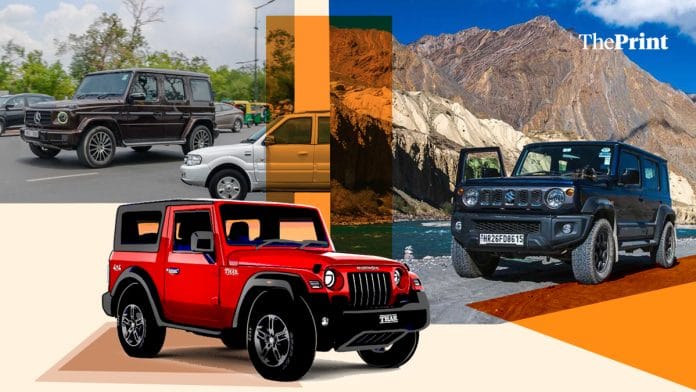New Delhi: Twenty-seven-year-old Vivek Dahiya was the star of his friend’s wedding in Haryana. Standing on top of his black Mahindra Thar, he showered cash on the dancing baraatis below. Dahiya was the “Maharaja”, the Thar his chariot.
“Just like women like to wear new dresses and jewellery at weddings, men also want to make a unique appearance. Arriving in a Thar was part of that. Who doesn’t love attention?” said Dahiya.
And he isn’t wrong. SUVs have long stood as symbols of muscle and machismo. After the cool, outdoorsy appeal of the Maruti Suzuki Gypsy in the 1990s, and the rise of the Gujjar-pride Fortuner and Jat-pride Scorpio in the 2000s, the Thar has now emerged as the new face of Indian middle-class male aspirations.
Even Kia, with its Seltos, has tried an aggressive posturing with its campaign tagline “Badass by Design”. Hyundai’s Creta, on the other hand, has sold aspirations of a big, high car with a polished image—cosmopolitan, urban, yet commanding. It is closer to the classical definition of a car. Tata Safari, however, has scaled back some of its ultimate SUV image in its current version to become more of a city car.
From being a favourite of off-roaders and a symbol of adventure, SUVs have now become a staple in the Indian cities. In the US car culture, SUVs are all about safe, family-friendly, suburban, soccer-mom lifestyle. In India, it is the complete opposite. It’s about adventure and risk-taking. Thar’s relatively affordable pricing and the overall cross-segmentation has brought in a new breed of customers to the SUV party.
The image of male SUV owners also changes for women with the brand name. In the early 1990s, the Gypsy-driving male—especially an olive green one—was seen as a carefree rebel who didn’t play by family rules, say brand managers. That rugged mantle passed on to Scorpio and Thar in the 21st century, with a topping of some daredevilry. Women SUV drivers are smashing the patriarchy—no matter which brand they choose.
The rugged image of SUVs is carefully crafted because everyone likes a vehicle with road presence and that tough feel.
– Hormazd Sorabjee, veteran auto journalist and editor of Autocar India
Veteran auto journalist and editor of Autocar India Hormazd Sorabjee says it’s the design of the SUV that drives its appeal—especially for young men.
“The rugged image of SUVs is carefully crafted because everyone likes a vehicle with road presence and that tough feel. People like high seating positions. The design of these vehicles is upright, they sit high off the ground, and they have strong power too. Hence, for men, it becomes a symbol of power,” he said.
The hierarchy of SUVs
It all started with the olive green, open-top Gypsy. Primarily used by the Army, the Gypsy soon assimilated into the mainstream as a symbol of national pride and ruggedness.
“Gypsy was associated with patriotism—seen in Independence Day parades, national parks, and always as a no-frills off-roader. When a regular person drove one, it evoked the imagery of toughness and risk-taking, much like the Army men who used it,” said Avik Chattopadhyay, brand strategist and former brand manager for Gypsy in the early 2000s.
In Shyam Benegal’s Manthan (1976), Girish Karnad, a young doctor posted in a Gujarat village, is seen driving an open-air vehicle—the Gypsy. The vehicle, Chattopadhyay said, gave Karnad an urban edge, portraying him as a saviour from the city who had come to help the villagers.
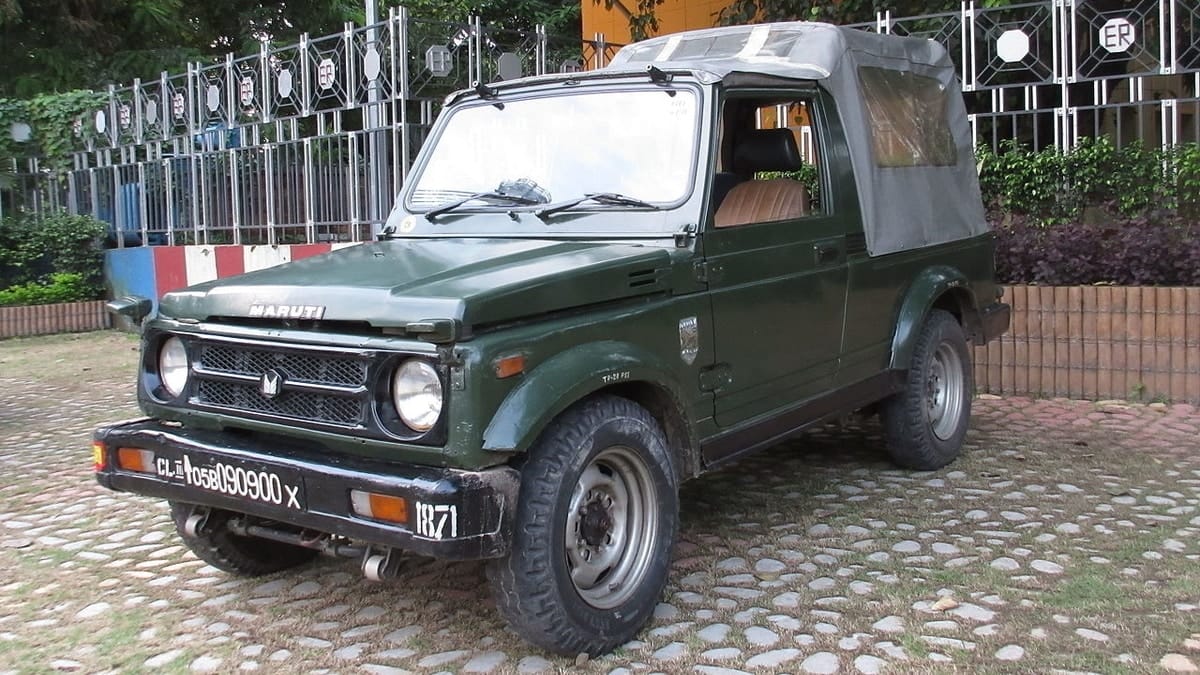
In today’s age, insiders at Maruti Suzuki call Jimny a replacement for the Gypsy. But it hasn’t quite filled the massive popularity of Gypsy as yet. Launched in India in 2023, the Jimny has positioned itself as tougher and more resilient. And the advertising plays a key role in emboldening its daredevil image. In one ad, a line from Merle Travis’ Dark as a Dungeon plays in the background—Where the dangers are plenty and too few the souls—as the Jimny cruises through mountainous roads and icy slopes.
The ad was widely praised for its cinematic brilliance. “After all, it’s not just a car—it’s a freaking JIMNY!!” wrote one user.
After the Gypsy, several SUVs have tried to capture that masochism. The Toyota Fortuner stands out for being a favourite among Indian politicians. A Reddit thread tried to dissect this trend, with one car enthusiast asking: “Why do most Indian politicians buy the Fortuner when money can give them so many other options?”
“The Fortuner, in particular, feels like a tank on wheels, and the strength of the Toyota badge adds immense credibility. That combination—reliability and presence—has made it a symbol of power”.
– Ketan Thakkar, Editor, Autocar Professional
The comments offered a glimpse into what goes through people’s minds when they see a Fortuner rolling down the road. One user wrote, “The Fortuner is the limit of the middle-class dream. Politicians are dream sellers. They won’t be able to sell middle-class dreams in a BMW or Mercedes.”
The Toyota Fortuner, launched in India in 2009, today costs between Rs 36 lakh and Rs 52 lakh (ex-showroom).
“It has a lot to do with the imposing road presence. The Fortuner, in particular, feels like a tank on wheels, and the strength of the Toyota badge adds immense credibility. That combination—reliability and presence—has made it a symbol of power,” said Ketan Thakkar, Editor, Autocar Professional.
He added that the Fortuner found strong acceptance among politicians and influential real estate developers. “Much like the Safari in its heyday, both vehicles resonated with people in power due to their commanding design, high seating, and sense of arrival”.
For automobile journalist Kushan Mitra, when people spot a white Fortuner, they assume a powerful person is sitting inside.
“So, it projects a certain image of ruggedness. You go to the Parliament parking lot and you will see a lot of white Fortuners. And politicians prefer the Fortuner because of Toyota’s reliability as they have to go to the places where roads can be really bad”.
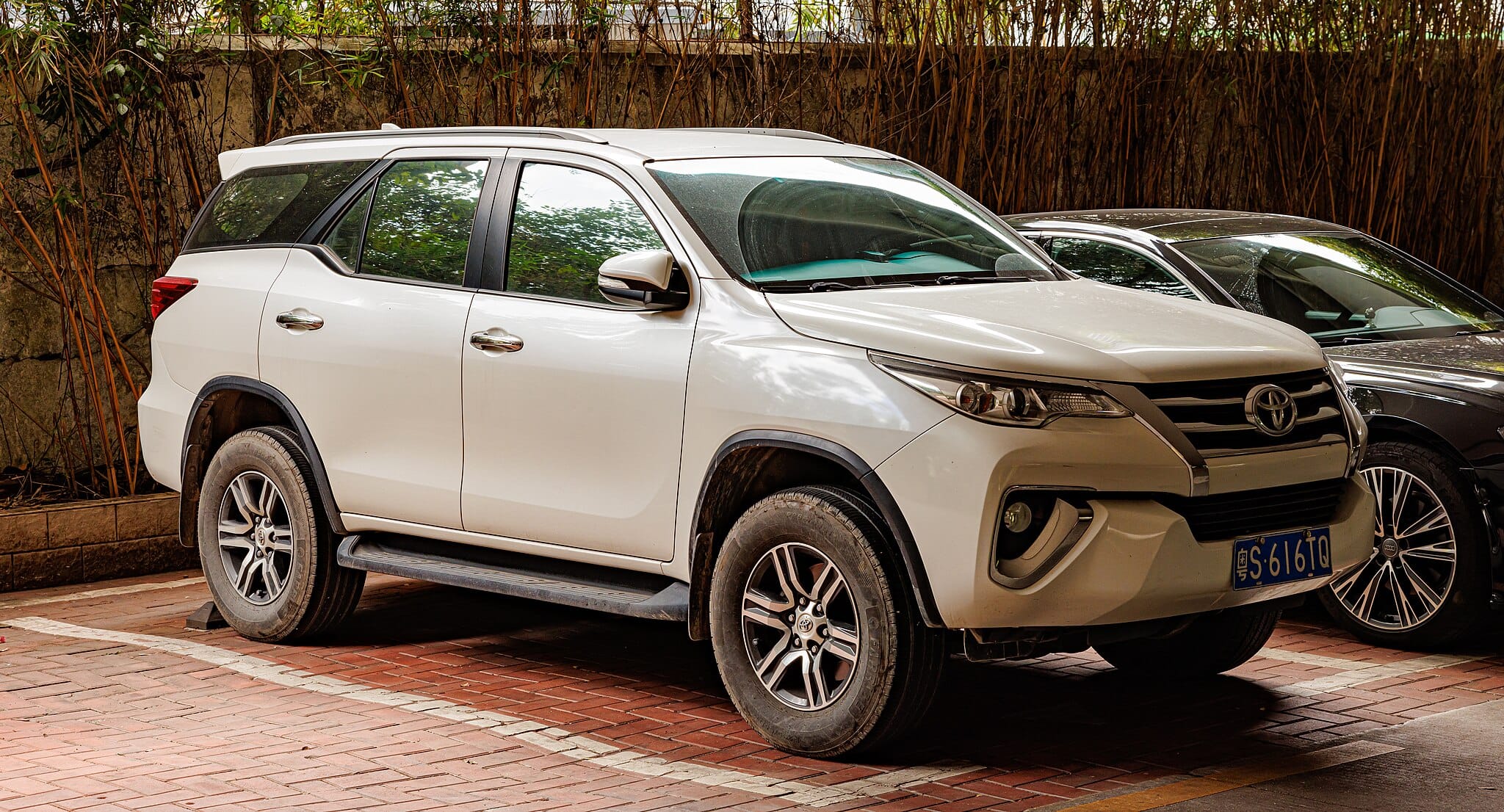
The hierarchy of SUVs in India, according to Mitra, is Fortuner for MPs and MLAs and Scorpio for Sarpanchs. The Tata Safari stepped aside from that league a few years ago with its current version. From being a sturdy SUV with a rugged character, the car has taken a new avatar.
“Safari of the old had a certain kind of buyer. It was an off-road car, but the safari of today is very different. It has the name plate but not the same personality. It is now more of a modern urban vehicle,” said Mitra.
Thar has taken the aggressiveness of SUVs to an entirely new level. No other Indian SUV appears to have made so many Indians explore off-roading. In one of its advertisements, a red Thar barrels through sand, water, and steep, uneven roads, kicking up clouds of dust in its trail. Titled The Making of an Icon | The All-New Thar | Development Story, the video features Naveen Chopra, Chief Product Head (Thar, Automotive Division), who calls it a “beast.”
“It’s not only a vehicle, it’s a beast,” he says. The video from 2022 has 1.4 million views.
Women haven’t remained untouched by the SUV trend. Social media is brimming with videos of women driving Thars, Jimnys, and Scorpios and giving reviews on YouTube—but they’re yet to become the protagonists in automobile advertising. However, in 2020, Mahindra had flagged off the Thar ‘Her Drive’ in Mumbai with 25 women ahead of the launch of its new-generation Thar.
“For women as well, it is the assertion of power but in terms of safety. A woman driving Thar, Jimny or Scorpio is seen as a powerful woman,” said Chattopadhyay.
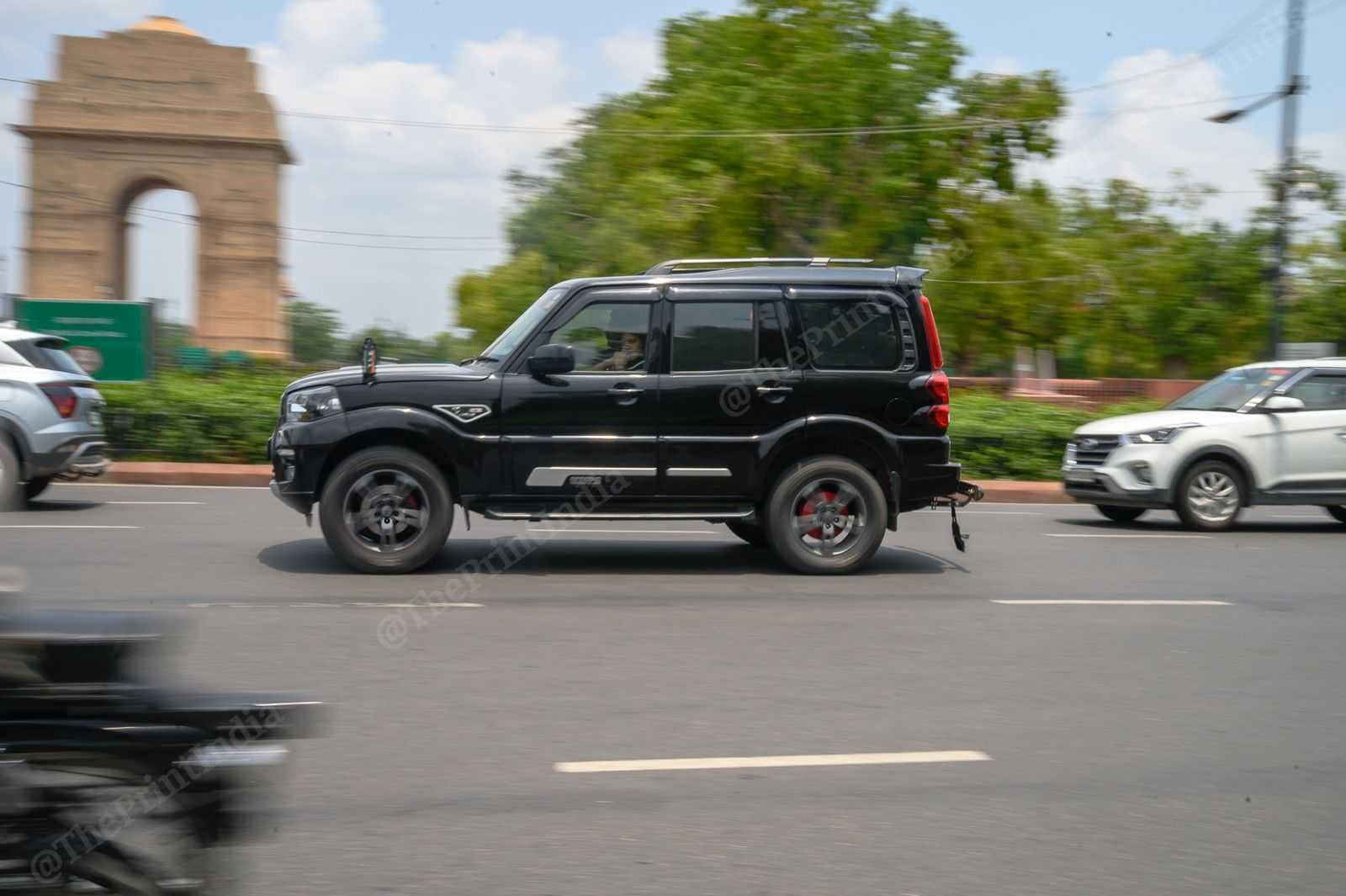
A research paper, titled Unleashing the Power of SUVs: Consumer Preferences and Future Prospects in India, by Vandana Shama, Gourav Gupta, and Shikhar Dangee, based on a sample of 181 respondents, explored the growing appeal of SUVs in the Indian market. According to the authors, consumer preferences are shaped by “greater size, visibility, and a rugged, sporty look,” along with practical features like “seating capacity and towing power.”
The study listed five key reasons why people choose to buy SUVs. Status and prestige led at 62.1 per cent, followed by peer influence or trend-following at 51.5 per cent. Other reasons included high ground clearance, off-road capability, and a higher driving position—all contributing to the SUV’s image of power, dominance, and control on the road.
Also read: Rajasthan village gets a dream school from Mumbai business tycoon. Sparks a rush in Rajsamand
Aftermarket treatment
When Irshad Khan sits on the driving seat of his white Thar, his posture changes. His back straightens and his face reflects a certain confidence. In that moment, he has transformed into a man with command. He demands attention now. And he gets too.
Why people are turning to SUVs is not for functionality but power and aggression. The society is getting more aggressive and Alpha. There is a lot of inner angst in people and therefore, they want to express themselves as more powerful than the others. And the best way to express that aggression on the road is by driving a large, bulky SUV.
– Avik Chattopadhyay, founder of the Indian School for Design of Automobiles
“When I take the car out on the road, people turn to look. They think, ‘this guy must have something that’s why he’s driving a Thar,’” he said, with a proud smile. Khan, 29, had three reasons for buying his new white Thar Roxx: Bhaukaal (swagger), izzat (respect) and jalwa (head turner).
The appetite for masculine projection on the roads isn’t always fulfilled at a showroom. There is an aftermarket for that.
Barely two months after buying the SUV, Khan came all the way from Hamirpur, Uttar Pradesh, to Delhi’s bustling Karol Bagh market, famous for car modification. Since he couldn’t afford a Land Rover Defender—his dream car—he decided to give his Thar Roxx the look of the SUV that costs upward of Rs 1 crore. A sturdy black toolbox mounted at the back, a metal foldable ladder welded at the base, and dual headlights affixed at the front, blinking in white and yellow. He couldn’t hide his happiness.
“Since I bought this car, I’ve barely driven it. But now that I’ve finally got my hands on it, I brought it straight to this market,” said Khan.
Now he’s planning his first off-roading trip with his wife to Manali. The vehicle, he says, has become his escape from the daily grind of a taxing job.
“My wife is counting down the days. She’ll be sitting in such a big car for the first time. When people see me driving it, she’ll feel like a proud wife,” he smiled.
Mitra said that Defender is a dream car for many. A car that projects that “you have made it.”
The music industry has been quick to catch on to the love affair between young men and their butch SUVs. The lyrics reinforce the macho image in the cultural imagination. In Instagram’s favourite song, Meri Kali Activa Da, which was released nine years ago, singer Rupinder Handa playfully describes how her lover relentlessly chases her; while she rides a black Activa, he follows her in his roaring Thar.
“Jadd oh maare, self Thar di, mere haath chon pedha girda ni.” (When he starts his Thar, even the dough ball—the woman is making rotis—slips from my hand.)
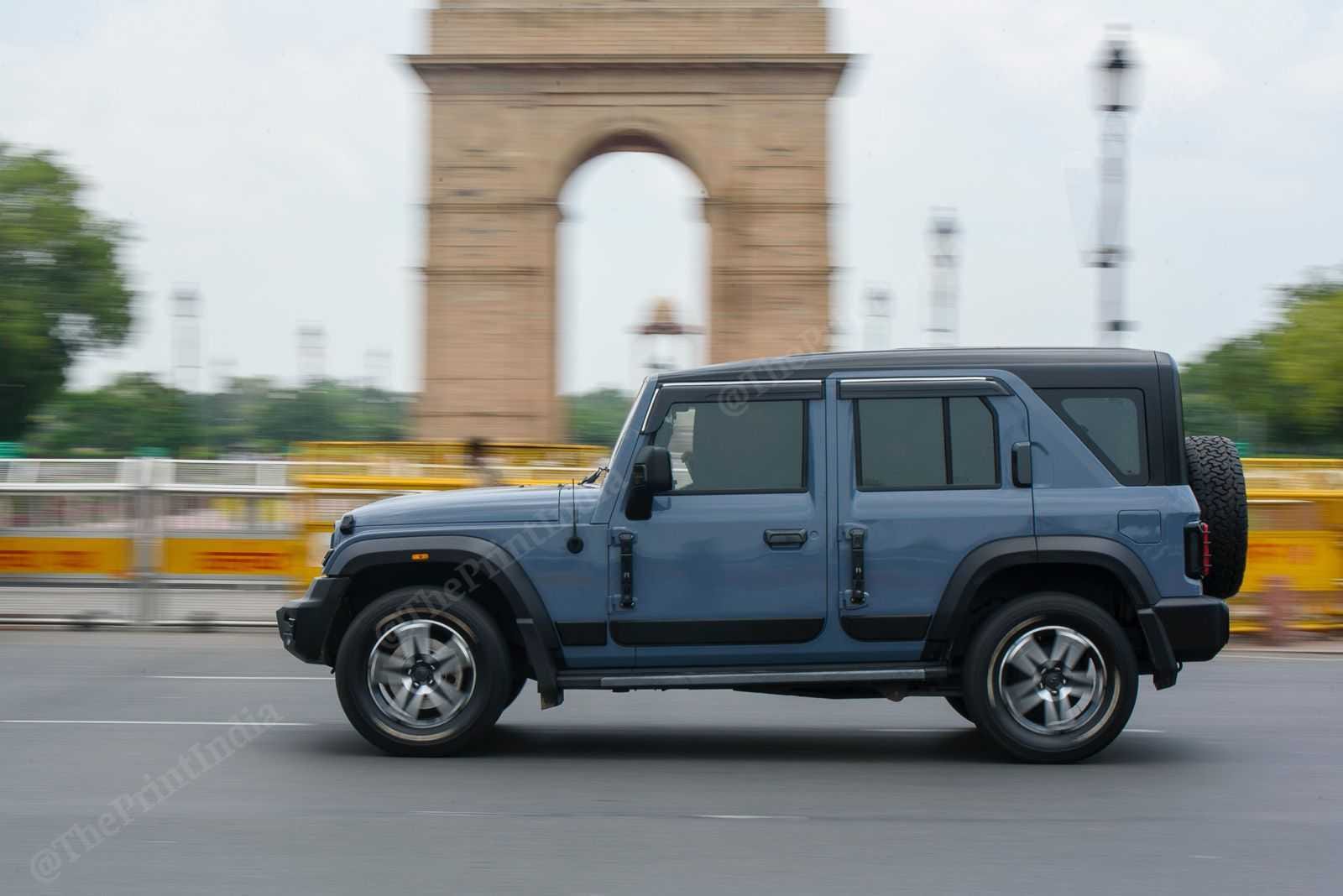
“Why people are turning to SUVs is not for functionality but power and aggression. The society is getting more aggressive and Alpha. There is a lot of inner angst in people and therefore, they want to express themselves as more powerful than the others. And the best way to express that aggression on the road is by driving a large, bulky SUV,” said Chattopadhya, who is also the founder of the Indian School for Design of Automobiles.
In Karol Bagh, meanwhile, the revving of engines reverberated in the air as Khan watched his brand-new Thar getting a makeover.
Khan is an SUV enthusiast and an ambitious one at that. Thar was not his first choice. He had initially planned to buy a Scorpio. But when Mahindra launched the Thar Roxx—the five-door version of the standard Thar with a long list of features and comforts—Khan changed his mind. Scorpio has its own following, especially in tier 2 markets, but the new Thar is a bigger head-turner.
“So, I went for the Thar. It had all the swagger and features of Scorpio for almost the same money. And Thar even has a sunroof,” said Khan, smiling ear to ear.
Khan, who runs an e-rickshaw agency in his hometown of Hamirpur, has become a famous man. Boys from the neighbourhood drop by just to catch a glimpse of the vehicle. And his phone keeps ringing, with friends requesting for a ride or to borrow it for weddings, or to take their wives on holiday.
Chattopadhyay says it was the Gypsy that kickstarted the era of car customisation in India. After the launch of the open-roof model, buyers began heading to local markets to get it fitted with hard tops and convert tops. And that’s how the customisation market gained the spotlight.
Irshad Khan is not the only one. A few steps away, Mushir Ahmed Khan called driving a Thar as riding a rhino. Son of a cop, he grew up watching his father drive a Maruti Gypsy, and now, at the age of 49, he wanted to reclaim the roads with Thar. And he came all the way from Aligarh to get his car modified.
“Since childhood, because of our father we have used that swagger. And now, when my brother and I decided we need to go on regular treks and that’s why we got this vehicle,” said Ahmed.
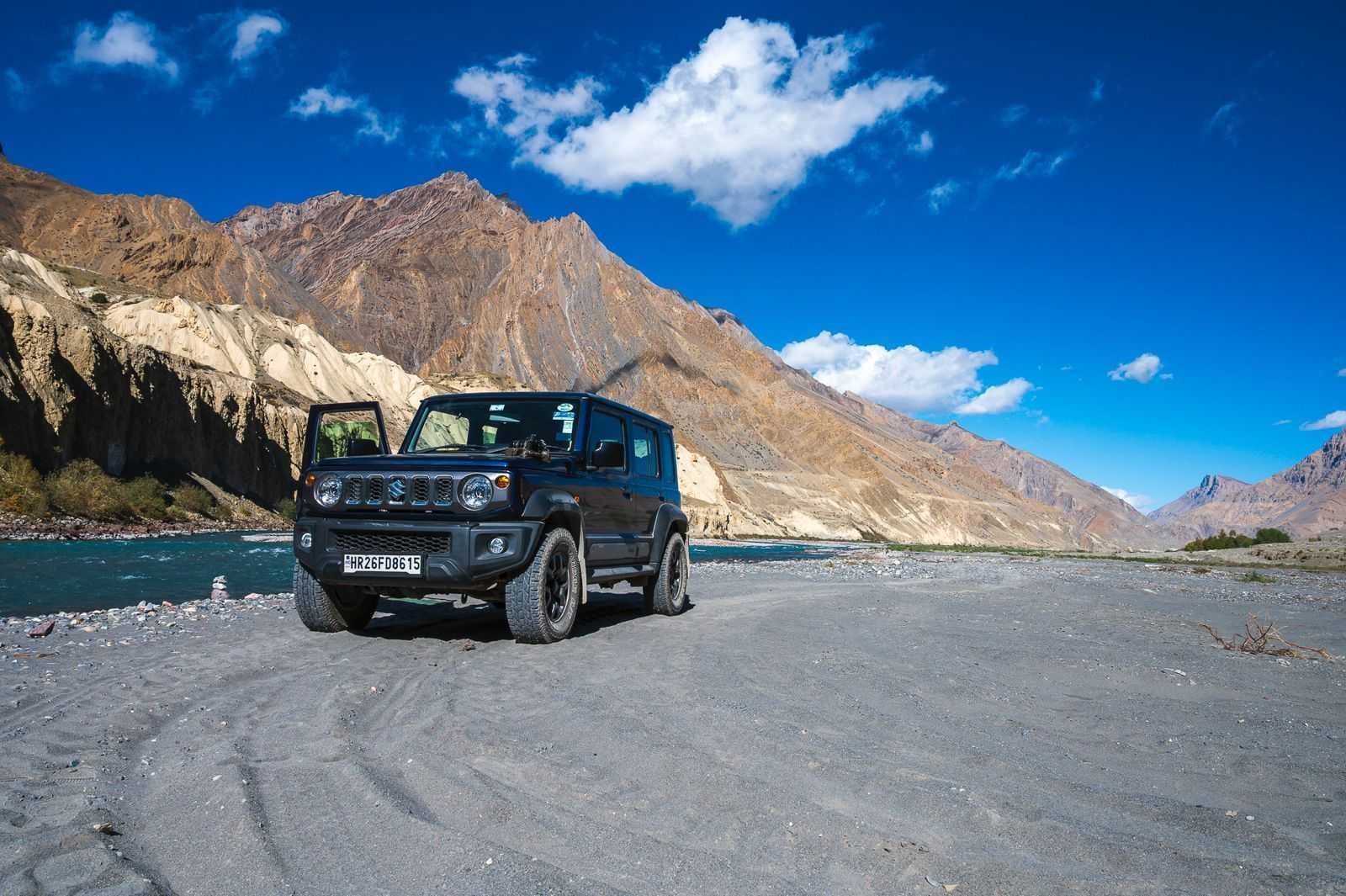
Nikhil Kumar, who has been modifying cars in Karol Bagh for the last 20 years, has witnessed the evolution of trends first-hand. From the Gypsy to the Bolero, Sumo, and now the Thar and Jimny—he says these vehicles have, at different times, captured the imagination of men.
As he pressed a button on a car’s steering wheel, a police siren blared through the air.
“Do you want this siren or some other sound?” he shouted over the noise.
Now, the store he works at is beaming with Thars, Scorpios, and Jimnys. And since the demand of the Thar has soared, Kumar said they have become exclusive Thar modifiers.
“And it’s going great. Every month we modify some 20-25 Thar on an average. People come for loud, blaring sirens, lights, ladders,” said Kumar, who is overseeing work on the three Thars parked outside the store—Black, White, Black.
Also read: Kia Syros stands out in a world of lookalike SUVs—and that’s not a bad thing
The advertisements
Hrithik Roshan emerges from the shadows, holding a small olive green, army-printed toy Jeep with “USA” emblazoned across it. As he walks forward, the silhouette of a real Jeep Wrangler comes into view.
With a pause and a smile, he introduces it as his “one and only”—the way one would introduce a partner. He jumps into the Wrangler and calls it “a benchmark so high, imitators can only fall short.”
Advertising plays a crucial role in adding aspirational value to an SUV—projecting it as a symbol of dominance, power, and identity. And the Jeep Wrangler couldn’t stay away for long. About a year ago, Jeep plunged into mainstream advertising in India with a high-profile campaign featuring Hrithik Roshan.
The comment section flooded with awe and accolades: “Finally, Jeep India has started mainstream marketing for the Wrangler. Good to see #HrithikRoshan in the ad. Would surely increase the sales.”
When Rattan Dhillon bought a Jeep Wrangler, it was because of his love for jeeps and the advertisement sent to his WhatsApp by a friend. The advertisement and the comment section gave him an adrenaline rush. A wave of exhilaration swept through him. And soon, he sold all his three Thars to buy the Wrangler.
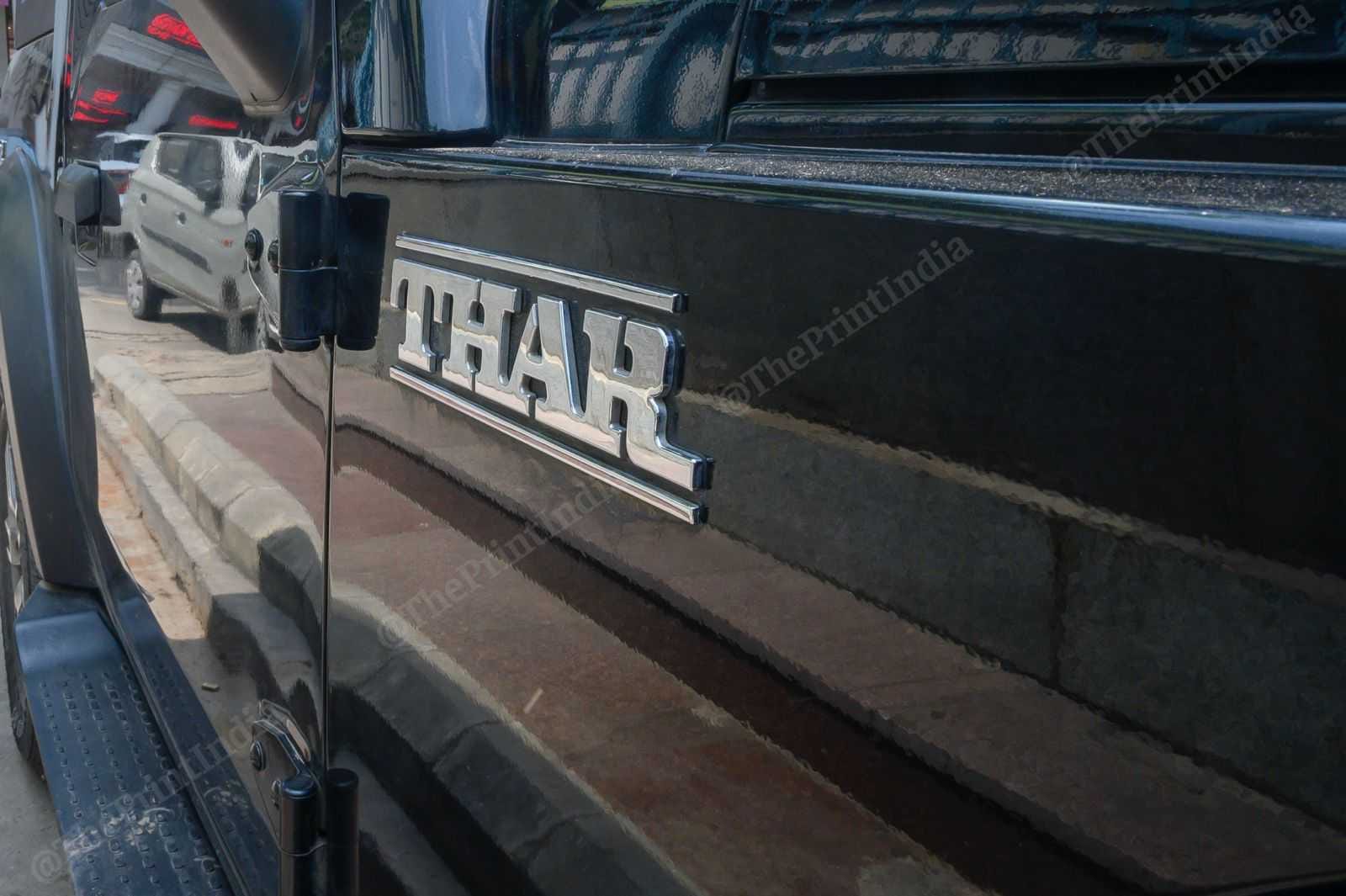
“It is a head-turner vehicle. Jeep Wrangler is a class. And the advertisement is bound to feature high profile celebrities as it depicts its elite character. So, yes, such advertisements instill a sense of pride and thrill,” said 27-year-old Dhillon.
A former Mahindra & Mahindra employee recalled how, in the past, the entire sales pitch for the Scorpio was built around a popular refrain in rural India: “Netaji ki Fortuner aur bahubali ki Scorpio.” And that sentiment still holds strong. The former employee, who wished anonymity, also claimed that the company struggled to sell its XUV700 in rural areas due to its softer, more urban image.
In the rural belts of Haryana and Uttar Pradesh, the Fortuner is synonymous with political power, while the Scorpio continues to represent the daredevil spirit.
Many influencers who make content on automobiles have also captured the anthropology of Indian SUVs. In one such reel, Instagramer Kaushal Amann, standing next to a black Scorpio, is asked, “Bahaiya ji, aap Thar ki jagah Scorpio kyun liye.”
Kaushal gives a prompt answer. “Aapne suna hoga, Scorpio ko Big Daddy of All SUVs kaha jata hai. Sabhi unchi gaadiyon k bade papa hain ye.”
In his quintessential UP dialect, he goes on to add, “Jab Thar kotwali mein baithaijaaegi, usko chhurwane Scorpio-N he jaaegi.”
A Scorpio owner from Haryana says this imagery has set a social expectation.
“It’s drilled so deep into people’s minds now—you have to buy a Scorpio or a Fortuner if you want to fit into that image box,” he said, laughing. “Even women want to marry a guy with a Scorpio or Fortuner.”
According to Mitra, with the Thar coming into the picture, the off-roading character of Scorpio has been supplanted, but its popularity among the urban population has risen.
“Scorpio has developed a more upmarket image and its price has also gone up. From off-roading, it has become a car of the rich,” said Mitra.
In contrast, rural regions continue to favour the sturdy Bolero. Mitra recalled a trip to the Chambal ravines in Uttar Pradesh last year, where Boleros lined the streets, serving as the go-to vehicle for locals. And he said that advertisements have a role to play in projecting all these SUVs as “go-anywhere” vehicles.
And monsoons are the ultimate test of machismo on the pothole-ridden city roads.
“In the monsoons, you’ll see people deliberately taking these cars through flooded streets—just to show they can go anywhere, that they’re indestructible,” said Sorabjee.
Also read: Noida’s Sports City is the biggest scam in its 50-year history. CBI probe to court cases
‘Tarnishing the image’
Dhillon said that buying a Jeep Wrangler wasn’t the sole reason he sold his Thars—it was also the image the Thar had acquired over time.
“A 4×4 vehicle like the Thar is affordable and accessible for off-roaders, and that’s a good thing. But people who have no understanding of off-roading are tarnishing our image by using the Thar to pull off stunts on city roads,” he said.
Dhillon, a resident of Chandigarh, who organizes national level expeditions said, “Thar has induced overconfidence among the middle class. They are trying to do off-roading on city roads and creating nuisance,” he said.
But Dhillon’s Rs 70-lakh Jeep Wrangler is not as accessible as a Rs 12-lakh Thar.
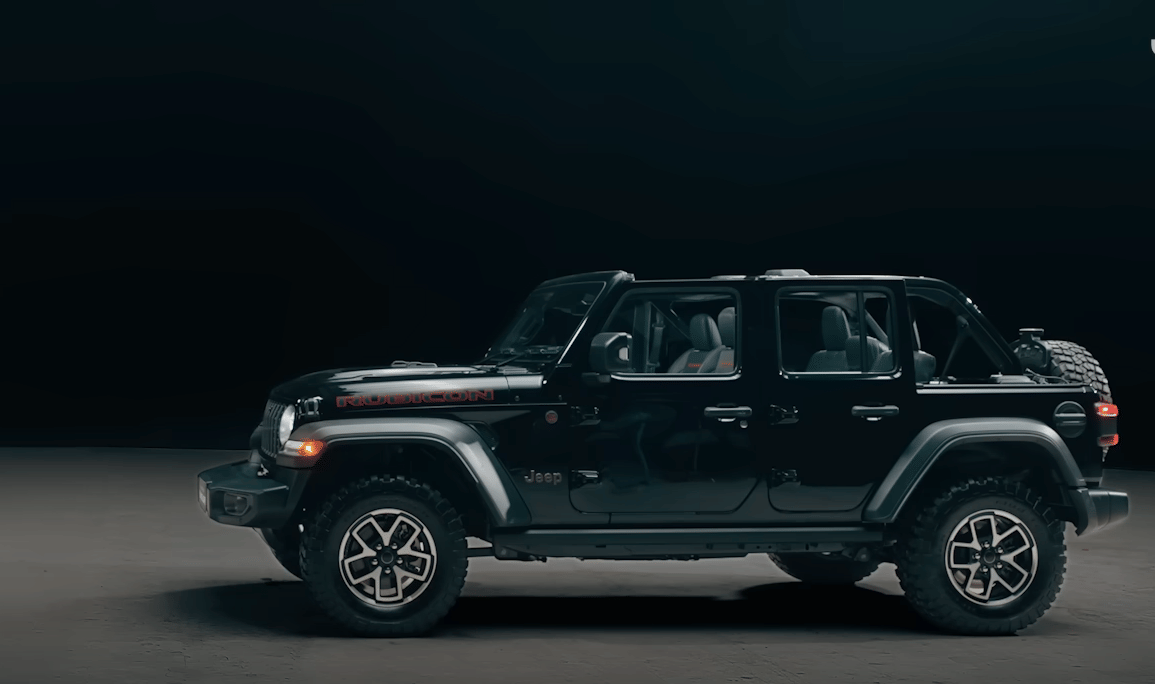
Dhillon’s social media is replete with posts questioning those who use Thar to create, what he calls, nuisance on roads. One of his posts read, “To Thar owners. Take the challenge to race off on this road instead of pulling stunts on the city roads.” After selling off his three Thars, he is now a proud Jeep Wrangler owner.
The recent accidents involving Thar have further harmed Thar’s image. On 5 May, a video went viral on social media showcasing a security guard being hit by a Thar driver in a fit of rage. The incident took place after the guard asked the driver to stop honking. The driver, Vijay, was seen reversing the car and running over the security guard after initially hitting him.
In another incident, Jaipur police arrested seven people and seized cars involved in “performing dangerous stunts”. Of the seized cars, 11 were Mahindra Thar and three were Mahindra Scorpios. ThePrint reached out to Mahindra and Mahindra via mails and calls for this story but didn’t receive a response.
An exclusive Thar group based in Delhi-NCR sees such incidents not exclusive to Thar, but as part of a broader SUV trend in India.
“Other SUVs are also involved in accidents. If only 1 percent of incidents involve a Thar, why malign the entire Thar community?” said a group member.
Last year in October, a Fortuner driver rammed into a sedan in Mohali, killing two friends. After the crash, the SUV driver hit the road divider and fled the scene on foot.
Meanwhile, an X user, Aaryansh, shared news of a Thar driver driving recklessly in Noida, and asked, “Is there a psychological shift that happens when someone buys a Thar? I’ve never seen a Thar owner drive sensibly.”
(Edited by Aamaan Alam Khan)



